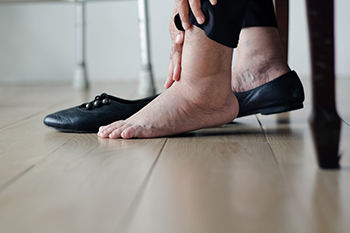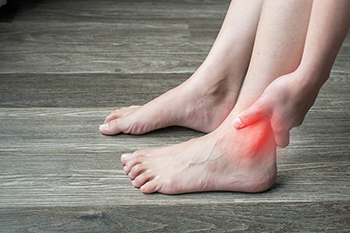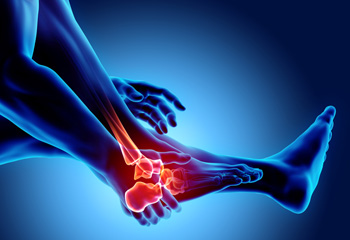Copyright © Michigan Foot and Ankle | Site Map | Nondiscrimination Policy | Design by: Podiatry Content Connection
January 2023
Swelling and Mosquito Bites

The feet can swell up in size and shape when they experience poor circulation. However, other things may cause the feet to swell. Namely, experiencing some kind of bug bite may make the feet swell. It is very common during the warm summer months for people to get mosquito bites all over their bodies, especially on their feet. If you are experiencing swelling on the feet from a mosquito bite, there are several steps that you may consider taking. To reduce and mitigate the extent to which your feet are swelling, you might consider applying an ice pack for a short amount of time to the affected area. About 10 minutes of application time might be sufficient. Generally speaking, the mosquito bite might also be washed with soap and water. Getting a mosquito bite on the feet shouldn’t be taken lightly if there is significant swelling. Contact a podiatrist today to learn more.
Swollen feet can be a sign of an underlying condition. If you have any concerns, contact one of our podiatrists of Michigan Foot and Ankle. Our doctors can provide the care you need to keep you pain-free and on your feet.
Swollen feet are a common ailment among pregnant women and people who stand or sit for extended periods. Aging may increase the possibility of swollen feet and patients who are obese often notice when their feet are swelling too. There may be medical reasons why swollen feet occur:
- Phlebitis - A condition that causes the veins to become inflamed and can also cause leg pain.
- Liver disease - This may lead to low blood levels of albumin which is a protein. This can cause fluid in the blood to pass into the tissues and several areas of the body can become swollen.
- Heart failure - When the heart doesn’t pump properly the blood that is normally pumped back to the heart can pool in the veins of the legs causing swollen feet.
- Kidney disease - One of the main functions of the kidneys is releasing excess fluid in the body. This type of condition can make it difficult for the kidneys to function properly, and as a result the feet may become swollen.
- Deep-vein thrombosis (DVT)- This is a serious condition where blood clots form in the veins of the legs. They can block the return of blood from the legs to the heart which may cause the feet to swell. It is important to be treated by a podiatrist if this condition is present.
Swollen feet can also be caused by bone and tendon conditions, including fractures, arthritis, and tendinitis. Additionally, there may be skin and toenail conditions and an infection may cause the feet to swell. Patients who take medicine to treat high blood pressure may be prone to getting swollen feet.
Many patients elevate their feet to help relieve the swelling and this is generally a temporary remedy. When a podiatrist is consulted the reason behind the swelling can be uncovered and subsequently treated.
If you have any questions please feel free to contact one of our offices located in Ferndale, and Milford, MI . We offer the newest diagnostic tools and technology to treat your foot and ankle needs.
Caring for Baby’s Feet

Baby’s feet are adorable and can melt your heart. Their feet are mostly made up of fatty tissue and are generally soft and pliable. At first baby’s feet may appear blue, wrinkled, and peeling, but as soon as a baby gets warm, their feet will become pink and fill out. It is important to care for a baby’s feet to make them strong enough for when they start walking. Their feet should be clean and clear of infection. Their feet should be allowed to grow, develop, and strengthen naturally. Wash and dry a baby’s feet daily. Sprinkle them with baby powder to assure they stay dry. Cut toenails straight across to ensure they do not grow into the skin. Make sure the baby has enough space to move their feet around, without being restricted. Exercise their feet by tickling their feet a bit so they can flex and stretch them. Have them wear socks versus shoes so movement is free. Examine the baby’s feet to make sure problems are not brewing. See a podiatrist for a proper evaluation and treatment if you see something amiss with your baby's feet.
Making sure that your children maintain good foot health is very important as they grow. If you have any questions, contact one of our podiatrists of Michigan Foot and Ankle. Our doctors can provide the care you need to keep you pain-free and on your feet.
Keeping Children's Feet Healthy
Having healthy feet during childhood can help prevent medical problems later in life, namely in the back and legs. As children grow, their feet require different types of care. Here are some things to consider...
Although babies do not walk yet, it is still very important to take care of their feet.
Avoid putting tight shoes or socks on his or her feet.
Allow the baby to stretch and kick his or her feet to feel comfortable.
As a toddler, kids are now on the move and begin to develop differently. At this age, toddlers are getting a feel for walking, so don’t be alarmed if your toddler is unsteady or ‘walks funny’.
As your child gets older, it is important to teach them how to take care of their feet.
Show them proper hygiene to prevent infections such as fungus.
Be watchful for any pain or injury.
Have all injuries checked by a doctor as soon as possible.
Comfortable, protective shoes should always be worn, especially at play.
If you have any questions please feel free to contact one of our offices located in Ferndale, and Milford, MI . We offer the newest diagnostic and treatment technologies for all your foot and ankle needs.
Twisting Your Ankle

A twisted ankle, or an ankle sprain, leads to overstretching or tearing of a ligament around the ankle. Ankle sprains make up 85% of ankle injuries. Such sprains usually occur from a sports injury, walking or running on uneven ground, or wearing high heels. Sprains can recur, so making sure to heal properly from a sprained ankle is important. If an ankle twists suddenly, it can force the foot outside its normal range of motion and place stress on the ligaments. When stretched beyond its normal limits, the ligament can start to tear. Torn ankle ligaments are most likely to occur in those under 30 years of age, regardless of gender. There will be mild to significant pain, swelling, and bruising depending on the severity of the sprain. The ability to walk will also be related to the grade of the sprain incurred. If you are having ankle pain after twisting your ankle, see a podiatrist for a proper diagnosis and treatment options.
Ankle pain can be caused by a number of problems and may be potentially serious. If you have ankle pain, consult with one of our podiatrists from Michigan Foot and Ankle. Our doctors will assess your condition and provide you with quality foot and ankle treatment.
Ankle pain is any condition that causes pain in the ankle. Due to the fact that the ankle consists of tendons, muscles, bones, and ligaments, ankle pain can come from a number of different conditions.
Causes
The most common causes of ankle pain include:
- Types of arthritis (rheumatoid, osteoarthritis, and gout)
- Ankle sprains
- Broken ankles
- Achilles tendinitis
- Achilles tendon rupture
- Stress fractures
- Bursitis
- Tarsal tunnel syndrome
- Plantar fasciitis
Symptoms
Symptoms of ankle injury vary based upon the condition. Pain may include general pain and discomfort, swelling, aching, redness, bruising, burning or stabbing sensations, and/or loss of sensation.
Diagnosis
Due to the wide variety of potential causes of ankle pain, podiatrists will utilize a number of different methods to properly diagnose ankle pain. This can include asking for personal and family medical histories and of any recent injuries. Further diagnosis may include sensation tests, a physical examination, and potentially x-rays or other imaging tests.
Treatment
Just as the range of causes varies widely, so do treatments. Some more common treatments are rest, ice packs, keeping pressure off the foot, orthotics and braces, medication for inflammation and pain, and surgery.
If you have any questions, please feel free to contact one of our offices located in Ferndale, and Milford, MI . We offer the newest diagnostic and treatment technologies for all your foot care needs.
Reminder: When Was the Last Time...?
How Does Charcot Foot Happen?
 The condition that is known as Charcot foot is considered to be a rare foot condition. It happens as a result of bones, joints, and soft tissues that gradually weaken in the foot and ankle. It can occur from nerve damage from diabetes and can cause the inability to feel pain. In severe cases, the bones may fracture from being weak, and the joints may become dislocated in the ankle or foot. If medical attention is not received, the foot can become deformed, and eventually may lead to the patient developing a bone infection or a foot ulcer. An additional reason why Charcot foot may happen can be from a fracture or sprain. The patient may continue to walk on the broken foot because they are unable to feel painful sensations, and the foot structure may change from trauma that is done to the bone. It is beneficial to begin treatment as early as possible, which generally starts with protecting the affected foot with a removable boot. Additionally, it is crucial to refrain from placing any weight on the foot until it begins to heal. If you have this rare foot condition, it is strongly advised that you are under the care of a podiatrist who can effectively diagnose and treat Charcot foot.
The condition that is known as Charcot foot is considered to be a rare foot condition. It happens as a result of bones, joints, and soft tissues that gradually weaken in the foot and ankle. It can occur from nerve damage from diabetes and can cause the inability to feel pain. In severe cases, the bones may fracture from being weak, and the joints may become dislocated in the ankle or foot. If medical attention is not received, the foot can become deformed, and eventually may lead to the patient developing a bone infection or a foot ulcer. An additional reason why Charcot foot may happen can be from a fracture or sprain. The patient may continue to walk on the broken foot because they are unable to feel painful sensations, and the foot structure may change from trauma that is done to the bone. It is beneficial to begin treatment as early as possible, which generally starts with protecting the affected foot with a removable boot. Additionally, it is crucial to refrain from placing any weight on the foot until it begins to heal. If you have this rare foot condition, it is strongly advised that you are under the care of a podiatrist who can effectively diagnose and treat Charcot foot.
Some foot conditions may require additional professional care. If you have any concerns, contact one of our podiatrists of Michigan Foot and Ankle. Our doctors can provide the care you need to keep you pain-free and on your feet.
Rare Foot Conditions
The majority of foot conditions are common and can be treated by a podiatrist. Standard diagnostic procedures are generally used to identify specific conditions and treatment can be rendered. A podiatrist also treats rare foot conditions which can be difficult to diagnose and may need extra attention and care.
There are many rare foot conditions that can affect children. Some of these can include:
- Freiberg’s disease
- Kohler’s disease
- Maffucci syndrome
Freiberg’s disease - This can be seen as a deterioration and flattening of a metatarsal bone that exists in the ball of the foot. It typically affects pre-teen and teenage girls, but can affect anyone at any age. Symptoms that can accompany this can be swelling, stiffness, and the patient may limp.
Kohler’s disease - This often targets the bone in the arch of the foot and affects younger boys. It can lead to an interruption of the blood supply which ultimately can lead to bone deterioration. The patient may limp or experience tenderness, swelling, and redness.
Maffucci syndrome - This affects the long bones in a child’s foot leading to the development of abnormal bone lesions. They are benign growths and typically develop in early childhood and the bones may be susceptible to breaking.
A podiatrist can properly diagnose and treat all types of rare foot conditions. If your child is affected by any of these symptoms or conditions, please don’t hesitate to call our office so the correct treatment method can begin.
If you have any questions please feel free to contact one of our offices located in Ferndale, and Milford, MI . We offer the newest diagnostic tools and technology to treat your foot and ankle needs.
Common Causes of Running Injuries

Most running injuries are caused by overuse, overtraining, improper footwear, and problems with biomechanics. Overtraining can be described as adding speed or distance too quickly, which can lead to overuse injuries like stress fractures and tendonitis. Experts recommend adding no more than 10 percent a week to the schedule. Another source of running injuries is wearing running shoes that either do not fit properly or have worn out. The wrong type of shoe for your foot can affect the gait, which can lead to injury. Also, shoes that are worn down or lack proper cushioning can cause pain in the feet, such as plantar fasciitis. Replacing shoes every 350-500 miles is recommended, and alternating pairs is thought to be beneficial. The way you run can also put you at risk. Striking with the heel first can cause shin splints and joint pain. Awareness of foot placement and body alignment are also important factors to be considered. Even the way you tilt your head can affect your muscles and breathing. For more information on avoiding running injuries, it is a good idea to consult a podiatrist for guidance.
Exercising your feet regularly with the proper foot wear is a great way to prevent injuries. If you have any concerns about your feet, contact one of our podiatrists of Michigan Foot and Ankle. Our doctors will treat your foot and ankle needs.
How to Prevent Running Injuries
Many common running injuries are caused by overuse and overtraining. When the back of the kneecap starts wearing out and starts causing pain in your knee, this is commonly referred to as runner’s knee. Runner’s knee is a decrease in strength in your quadriceps and can occur if you’re not wearing properly fitted or supporting shoes. To prevent runner’s knee, focusing on hip strengthening is a good idea, as well as strengthening your quads to keep the kneecaps aligned.
What Are Some Causes of Running Injuries?
- One cause of a common running injury is called iliotibial band syndrome.
- Plantar fasciitis is also another common injury.
- Stress fractures can occur from overtraining, lack of calcium, or even your running style.
Best Ways to Prevent Running Injuries
- Wear footwear that fits properly and suits your running needs.
- Running shoes are the only protective gear that runners have to safeguard them from injury.
- Make a training schedule. Adding strengthening exercises as well as regular stretching can help keep you strong and limber and can lessen the possibility of injuries.
- Stretching keeps muscles limber; this will help you gain better flexibility.
If you have any questions please feel free to contact one of our offices located in Ferndale, and Milford, MI . We offer the newest diagnostic and treatment technologies for all your foot and ankle needs.







